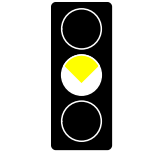Hand Signals - by Police Officers

Traffic approaching
from the front to STOP

All traffic to STOP

Traffic approaching
both from front and
behind to STOP

Traffic from the right to
proceed

Traffic from the front to
proceed

Traffic from the left to
proceed
Danger Warning Signs

Left Bend Ahead

Right Bend Ahead

Double Bend to Left Ahead

Double Bend to Right Ahead

Hair Pin Bend to Right
Ahead

Hair Pin Bend to Left
Ahead

Dual Carriage-way Starts
Ahead

Dual Carriage-way Ends

Road Narrows Ahead

Road Narrows on the Left Side Ahed

Road Narrows on the
Right Side Ahed

Cross Roads Ahead

Staggered Junction
Ahead with First Side
Road to Left

Staggered Junction
Ahead with First Side
Road to Right

“T ” Junction Ahead

“Y’ Junction Ahead

Traffic From Left Merges
Ahead

Traffic From Right
Merges Ahead

Narrow Bridge or Culvert
Ahead

Two-way Traffic Ahead

Stop Ahead

Give Way Ahead

Roundabout Ahead

Light Signals Ahead

Dangerous Descent
Ahead

Dangerous Ascent
Ahead

Slippery Road Ahead

Loose Aggregate/
Gravel Ahead

Falling Rocks Ahead

Pedestrian Crossing
Ahead

Children present/
crossing Ahead

Road Work Ahead

Blind people crossing
Ahead

Level Crossing with
Gates Ahead

Unprotected Level
Crossing Ahead

Bus Lane Ahead

Cycle Lane Ahead

Cyclist crossing Ahead

Cattle Crossing Ahead

Road Ahead on a Quay

Dangerous Side Slopes
Ahead

Road Hump Ahead
REGULATORY SIGNS | Prohibitory Signs

No entry

No Left Turn

No Right Turn

No U-turn

No Overtaking

No Horning

Road Closed for all
vehicles

Road closed for
Motor vehicles

Road Closed for
Buses

Road Closed for
Lorries

Road closed for
Articulated vehicles

Road Closed for Power
Driven Agricultural
Vehicles

Road Closed for
Pedestrians

Road Closed for
Cycles

Road Closed for
Motorcycles

No Parking

No Parking and
Standing

No Parking on
Odd days

No Parking on
Even days
Mandatory Signs

Turn Left

Turn Right

Straight Ahead

Turn Left Ahead

Turn Right Ahead

Pass Left Side

Pass Right Side

Compulsory
Roundabout
Priority Signs

Stop to give priority
to vehicles on the
adjacent road

Give Way to vehicles
on the adjacent road

Priority Road to
vehicles on the
major road

End of Priority given to
vehicles on the major
road

Priority for the
Oncoming Traffic

Priority over Oncoming
Traffic Vehicles
Restrictive Signs

Width Limit

Height Limit

Weight Limit

Weight Limit on
One Axle

Vehicles within
built-up areas except
for 3 wheelers and land
vehicles

End of Speed Limit
Other Signs Useful For Drivers

Pedestrian Crossing

One Way Traffic flow

Hospital

Parking

Parking for
Handicapped
Persons

Bus stop

Bus only Lane Begins
or Continues

Bus Only Lane Ends

Cycle only Lane
Begins or Continues

Cycle only Lane Ends

Cycle and Pedestrian
Lane Begins or
Continues

Cycle and Pedestrian
Lane Ends

Pedestrian Underpass

Pedestrian Overpass

Entrance to an
Expressway

End of Expressway

Streets for Pedestrians
only
Road Markings

Stop Line at “STOP”
signs or at Traffic
Signals

“Give Way”” line at
“Give Way” signs at
Roundabouts

Broken Centre Line
Marking

Broken Centre Line
Markings incorporating
studs or cat eyes

Broken Centre line
marking with Reflective
studs for high Speed
Highways and
Expressways

Longitudinal
Continuous Centre line

Combination of a
Broken Center Line and
a Continuous Line

Combination of a
Continuous Centre Line
and Broken Line

Combination of a
Broken Centre Line and
a Continuous Line with
Reflective Studs

Combination of Broken
Line with a Continuous
Centre Line with
Reflective Studs

Longitudinal Double
Continuous Centre Line

Longitudinal Double
Continuous Centre Line
with Reflective Studs
Crossing.

Lane Marking

Longitudinal Edge Line

Longitudinal Line with
Reflective Studs

No Parking Line
(yellow line)

No Parking Double
Line (yellow lines)

No Parking Double
Line with Reflective
Studs (yellow line)

Hatch line for traffic in
opposite direction

Hatch line for traffic in
same direction
(approaching)

Hatch line for traffic in
same direction
(leaving)

Compulsory left
turn

Compulsory right
turn

Compulsory straight
ahead

Traffic Lanes ahead

SLOW

STOP

BUS LANE

CYCLE LANE

Cyclist Crossing

Hazard Warning Line

Bus lane

Junction Box
(Yellow Lines)

“ZEBRA” Pedestrian
Crossing on a
Two-Lane Road
Junction



Alternative Positions Of Traffic Light Signals
Red Light
A red light means STOP and vehicles shall not proceed beyond the stop line or, if there is no stop line, shall not proceed beyond the line of the signal or, if the signal is placed in the middle or on the opposite side of an intersection, shall not enter the intersection or move on to an area designated for a Pedestrian Crossing at the intersection.
Red and Amber Lights
Red and Amber means STOP. An
amber light, which appear at the same time with the red light shall mean that the signal is about to change. Do not proceed until Green light appears .
Green Light.
A green light means that traffic may proceed straight or may turn left or right; with safety. However, a green light for controlling traffic at an intersection shall not authorize
drivers to proceed if traffic is so
congested in the direction in which
they are about to proceed and if they enter the intersection they would probably not have cleared it by the next change of phase.
Amber Lights
An amber light, which appears alone shall mean that no vehicle may pass the stop line or beyond the line of the signal unless it is so close to the stop line or signal when the light appears that it cannot be safely stopped before passing the stop line
or beyond the line of the signal.

Flashing Amber lights
A single amber flashing light shall
mean that drivers reduce speed and
may proceed but shall do so with
particular care. Amber flashing light
may be used in place of a three –
colour system at time when traffic is
light, particularly in the nights.
Amber Flashing Light Signals are
placed at intersections. They are
operated only at times when traffic
lights are not operated.